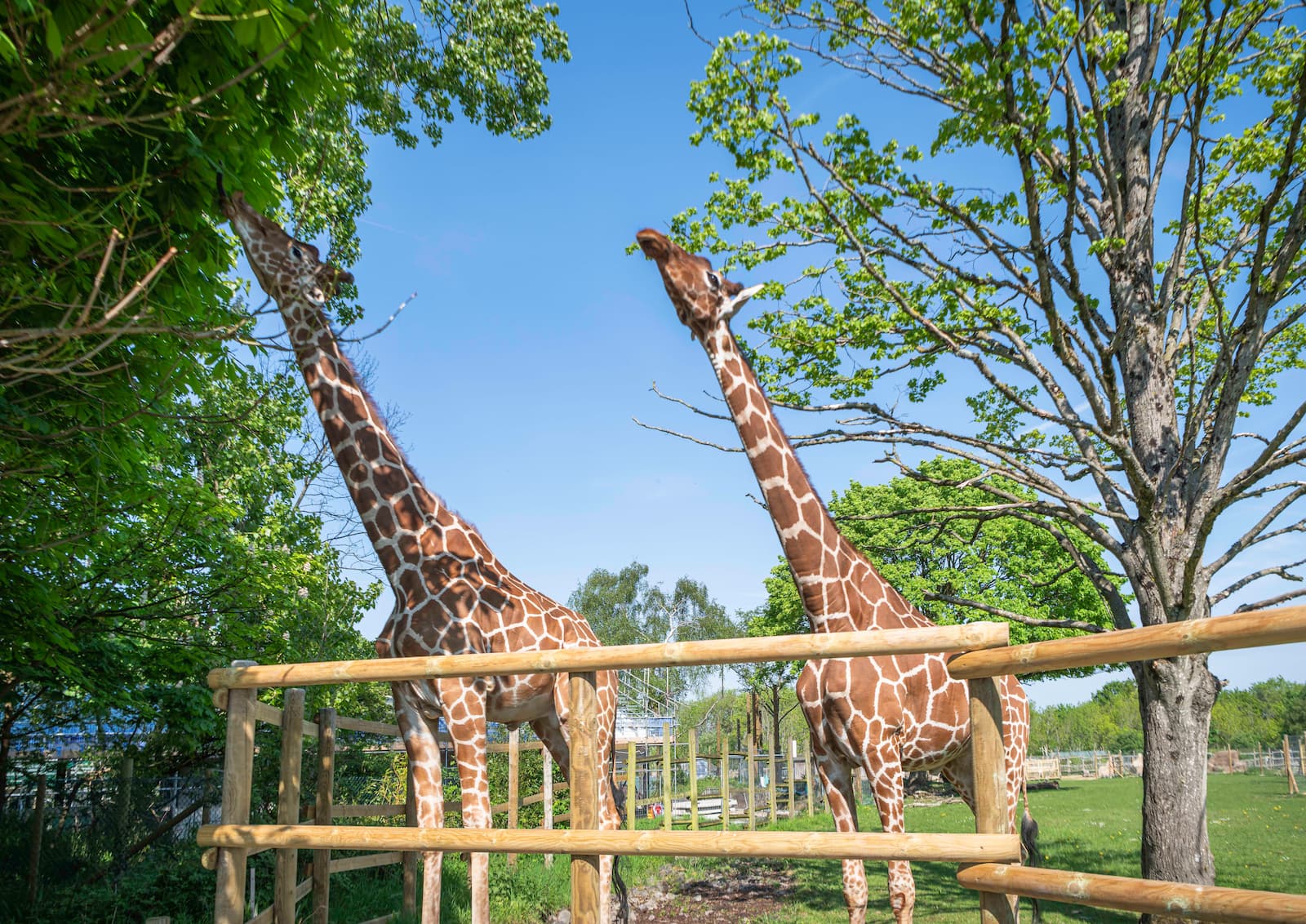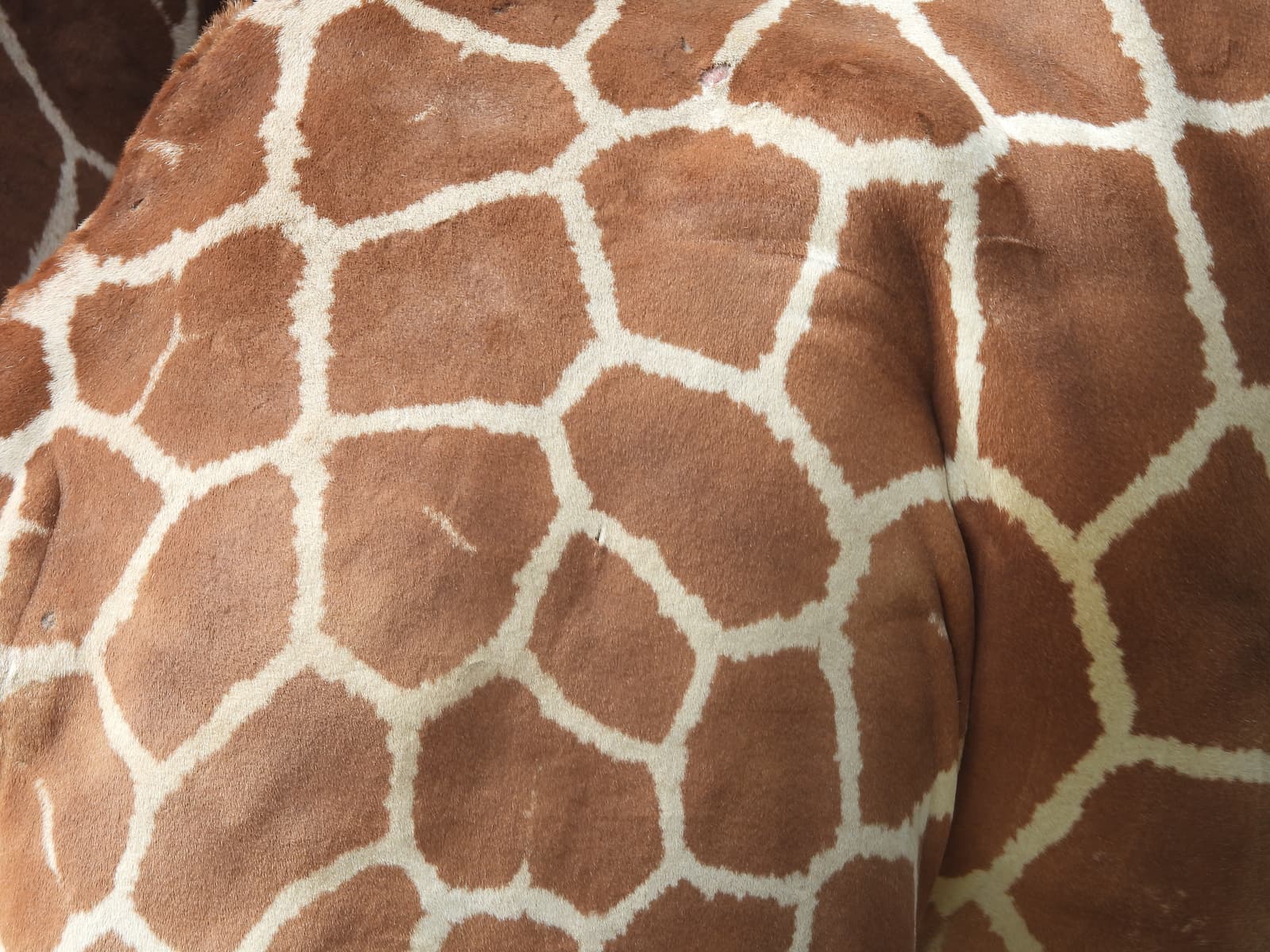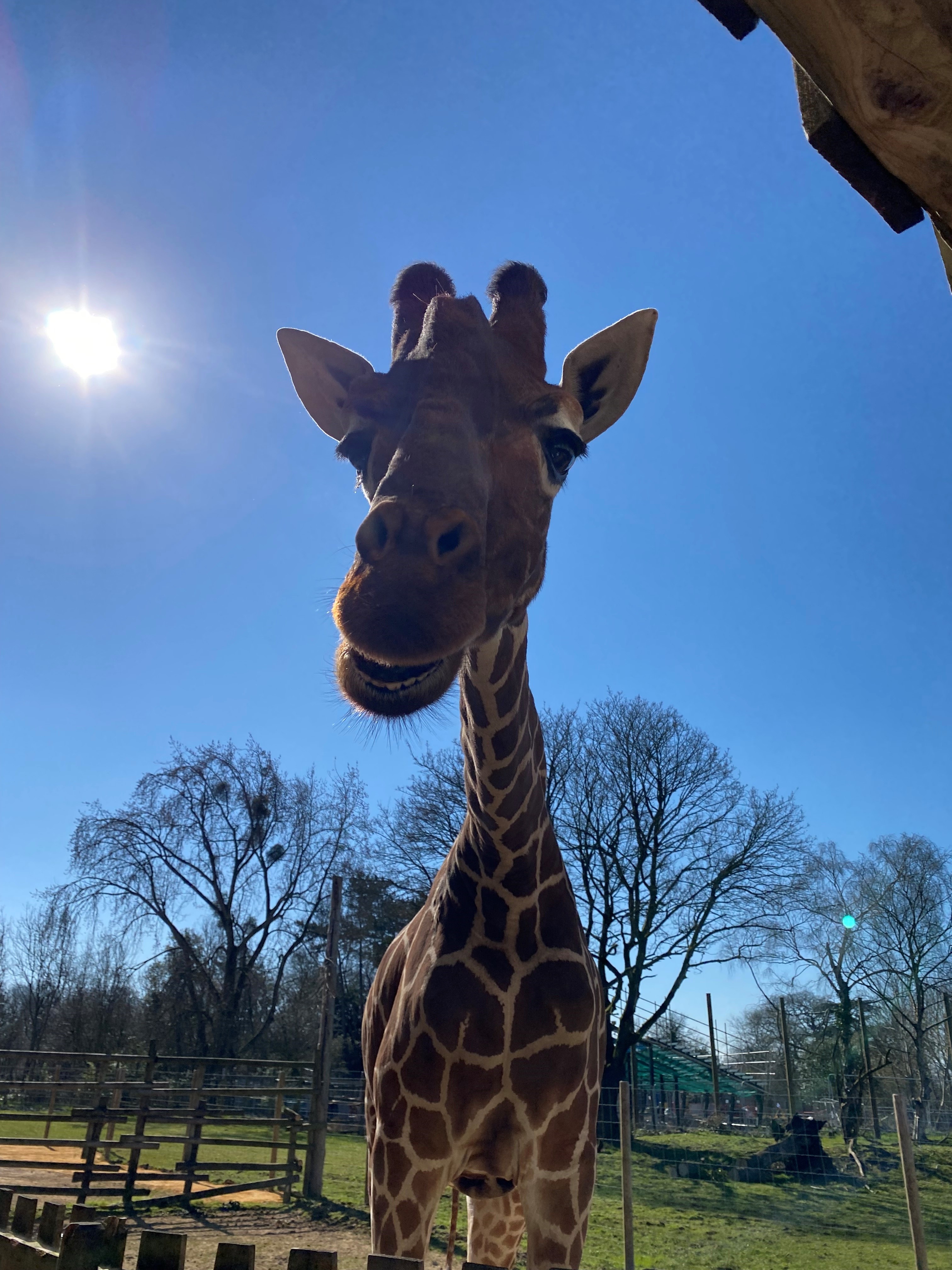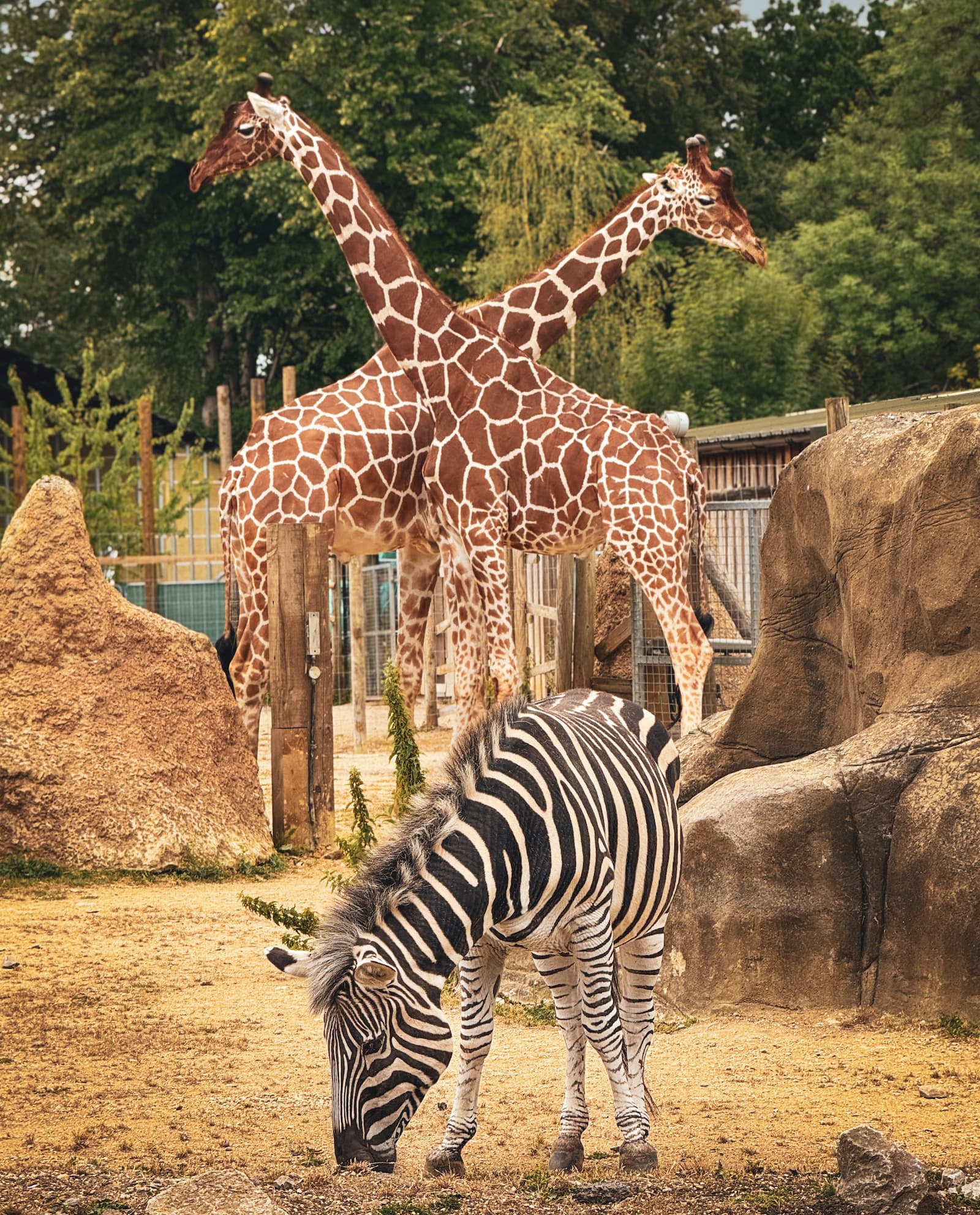
7 amazing facts about giraffes
Posted on: 4 August, 2025
Gentle giant herbivores who are uniquely adapted to browse tall vegetation, giraffes are known for their long necks, long tongues, and even longer legs.
There are around 117,000 individuals living in the wild and although the number of subspecies is widely disputed, there are currently nine recognised by the IUCN, some of these subspecies face critical threats and endangerment.
With an array of fascinating and lesser-known features, here are 7 amazing facts about giraffes that will change the way you think about these incredible creatures.
 1. Giraffes are really, REALLY, tall
1. Giraffes are really, REALLY, tall
Well known for their long necks, giraffes are the world’s tallest mammals and living land animals. An adult male can grow to around 5.5m or 18 feet – that’s taller than a double-decker bus or three adult humans - with even newborn giraffes exceeding the height of most humans at an average of 1.8m or 6 feet.
A giraffe’s neck can be more than 2m long or 7 feet, but they have the same number of vertebrae in their neck as humans. The difference being that each of a giraffe’s neck vertebrae is close to 30 cm long, whereas the longest human vertebrae is around 3.5 cm.
2. Giraffes have unique coat patterns
Similar to human fingerprints and gorilla nose prints, each giraffe has a unique coat pattern that allows for individual identification. Calves inherit some coat pattern traits from their mothers, but all remain unique, and are often linked to the giraffe's geographic location and habitat.
Each subspecies also has some very different and distinct pattern features. For example, our two reticulated male giraffes at Bristol Zoo Project have a striking pattern of large, brown-orange, polygon spots separated by narrow, bright white lines, compared to other species that have lighter or darker, more jagged spots, as well as thinner lines.
These patterns play a crucial role in protecting them from predators, helping them to remain camouflaged in their native habitats. However, another cool fact about giraffe spots is that they act as “thermal windows” that regulate giraffes' body temperatures. Surrounding each patch is a relatively large blood vessel that branches into smaller vessels underneath the patch. Giraffes can direct blood through these small branches into the centre of the patch to release heat.
 3. Drinking is somewhat of a challenge
3. Drinking is somewhat of a challenge
Giraffes have a unique challenge when it comes to drinking. Their necks are too short to reach the ground, so they must splay their forelegs or bend their knees to lower their necks to the water’s surface.
Giraffes spend most of their day eating and surprisingly drink only once every few days, even when water is readily available, getting most of their water from the plants they eat.
To protect the giraffe’s brain from sudden changes in blood pressure while drinking, they can involuntarily control blood flow to the brain thanks to jugular veins with elastic walls and large one-way valves. These adaptations allow the veins to expand significantly and prevent blood from flowing back to the brain when lowering the head to drink.
4. They have super strong and long tongues
Giraffes have strong tongues that can grow up to 53 cm long, which helps them to get their food and get it fast.
Herbivores, giraffes only eat plants, and their favourite food is the acacia tree. They use their long necks to reach the leaves and buds in the treetops and their strong and long tongues to pull down leaves growing way up high while avoiding the thorny spikes on the branches.
A giraffe's tongue is typically dark purple, blue, or black towards the front, with a pinkish base near the throat and this dark colouration is thought to protect the tongue from sunburn while feeding.
 5. Giraffes move in towers
5. Giraffes move in towers
Giraffes are very social animals and roam around in groups in the wild. These groups, called towers, typically have around 15 members led by an adult male. The other members are females and young males.
6. Female giraffes give birth standing up
As female giraffes give birth standing up, this means that newborns often enter the world with a bang – a 1.5 m drop to the ground! However, these infants usually get to their feet within 30 minutes, and only hours later can run with their mothers.
The gestational period of a giraffe lasts for fifteen months, and while most births are single, there may occasionally be twins.
Giraffes do not choose a mate for life, and a male will usually walk through a group of females looking for a fertile mate. He will work out if the timing for fertilisation is right by tasting the urine of a female.
7. Giraffes are expert communicators
Giraffes communicate with each other through a combination of visual cues, including body posture and eye contact, physical touch, as well as vocalisations that are often too low a frequency to be detected by the human ear. At night, they make a humming or snoring sound, which is thought to act as a reassuring signal to other members of the tower in the dark.
Giraffes can also make audible noises, although not often. For example, during the mating season, the males produce coughing sounds to attract females, and a cow may whistle to her young, emitting a noise similar to the sound of a flute, to warn them of potential danger. They have also been known to make sounds such as bellowing, hissing, and snorting.
 We work to conserve the Critically Endangered Kordofan giraffe in Cameroon, of which fewer than 2,000 exist. You can also visit our reticulated giraffes, Tico and Dayo, in our Bénoué National Park habitat here at Bristol Zoo Project.
We work to conserve the Critically Endangered Kordofan giraffe in Cameroon, of which fewer than 2,000 exist. You can also visit our reticulated giraffes, Tico and Dayo, in our Bénoué National Park habitat here at Bristol Zoo Project.
Bristol Zoo Project is run by Bristol Zoological Society, a conservation and education charity. Every visit supports our mission to protect nature now and into the future here in the UK and around the world.

